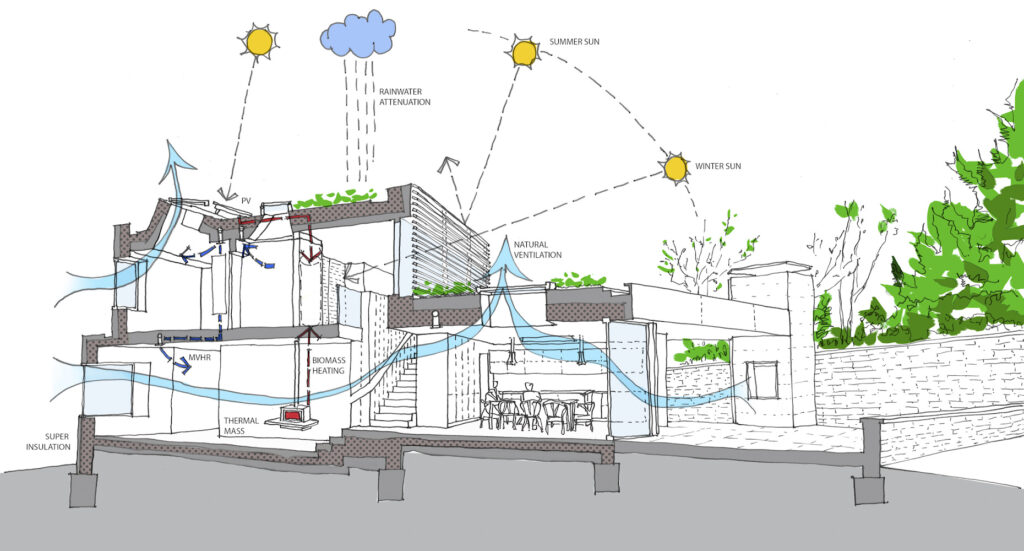Passive Design Strategies

Introduction: The Power of Passive Design
Passive design is the art of using a building’s form, materials, and site orientation to maximize comfort and minimize energy consumption—without relying on mechanical systems. For recent graduates, mastering these strategies is no longer optional:
- Regulatory Push: Building codes like IECC 2021 mandate passive measures.
- Cost Savings: Proper passive design can reduce HVAC loads by 40–60%.
- Climate Urgency: Buildings account for 39% of global CO₂ emissions—passive design is a frontline solution.
In This Guide:
✔ Core principles of bioclimatic design
✔ Real-world examples from desert to arctic climates
✔ Technical standards and step-by-step workflows
✔ Common pitfalls and how to avoid them
Theoretical FoundationsFive Pillars of Passive Design
Solar Orientation
- Key Term: Solar azimuth (sun’s path) dictates building alignment.
- Rule: Elongate buildings on east-west axis in temperate zones.
- Thermal Mass
- Materials like rammed earth or concrete absorb/release heat slowly.
- Example: Traditional adobe houses stay cool in daytime, warm at night.
- Natural Ventilation
- Stack effect (hot air rises) + cross-ventilation drive airflow.
- Insulation & Airtightness
- Standard: Passivhaus requires ≤0.6 ACH (air changes per hour).
- Shading & Glazing
- Overhangs calculated using solar angle calculators.
Historical Context: Persian windcatchers (1300 BCE) and Roman hypocausts pioneered passive heating/cooling.
Practical ApplicationsCase Study 1: Pearl River Tower, Guangzhou (Skidmore, Owings & Merrill)
- Strategies:
- Double-skin façade with ventilated cavity
- Building shape funnels wind to turbines
- Result: 58% energy reduction vs. conventional towers.
Case Study 2: Nk’Mip Desert Cultural Centre, Canada (DGBK Architects)
- Strategies:
- Rammed earth walls (R-30 insulation equivalent)
- Buried cooling tubes
- Challenge Solved: Extreme diurnal temperature swings.
Case Study 3: House Zero, Texas (Lake|Flato Architects)
- Strategies:
- Deep porches (4ft overhangs at 30° latitude)
- Operable wood screens
- Data: 76% less cooling energy needed.
Technical Considerations
Climate-Specific Standards
| Climate Type | Key Strategy | Standard |
|---|---|---|
| Hot-Arid | Night purge ventilation | ASHRAE 90.1-2022 |
| Cold | Triple-glazed windows + thermal breaks | Passivhaus PHPP |
| Humid | Elevated structures + roof vents | IECC Section C402 |
Critical Calculations
- SHGC (Solar Heat Gain Coefficient): ≤0.25 for hot climates.
- U-Value: Windows ≤0.15 BTU/(hr·ft²·°F) in cold zones.
Tool: Use Climate Consultant software to tailor strategies to local weather data.
Implementation GuideStep 1: Site Analysis
Sun Path: Use SunCalc.org to plot seasonal angles.
- Wind Roses: Download from NOAA for prevailing breezes.
Step 2: Design Development
- Massing:
- Hot climates: Compact forms to minimize surface area.
- Cold climates: Southern exposure for solar gain.
- Envelope:
- Specify materials using the BECP Compliance Tool.
Step 3: Detailing
- Shading Devices:
- Formula: Overhang depth = (Window height) × tan(summer solar altitude).
Common Mistakes & Solutions
| Mistake | Solution | |
|---|---|---|
| Over-glazing south facades | Use Window-to-Wall Ratio (WWR) ≤40% | |
| Ignoring thermal bridging | Specify continuous insulation (ci) | |
| Poor airtightness |
|
Pro Tip: Mock up wall sections at 1:1 to test thermal performance.
Resources & Tools
Software
- Sefaira: Real-time passive design analysis.
- Ladybug Tools: Climate-specific solar studies.
Learning
- The Passive Solar Energy Book (Edward Mazria).
- AIA 2030 Commitment training modules.
Organizations
- Passive House Institute (PHI).
- BuildingGreen for product guides.
Conclusion: Designing With Nature Passive design isn’t just technique—it’s a mindset. As you start your career:
- Prioritize site analysis before sketching.
- Advocate for passive measures even on conventional projects.
- Test relentlessly: Energy models ≠ real performance.
Your First Assignment: Audit a local building’s passive features using the BECP Checklist.